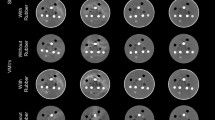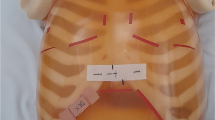Abstract
Introduction
The additional radiation exposure applied to patients undergoing cone-beam computed tomography (CBCT) for image registration in radiation therapy is of great concern. Since a decrease in CBCT dose is linked to a degradation of image quality, the consequences of dose reduction on the registration process have to be investigated.
Material and methods
This paper examines image quality and registration of low-contrast structures on an Elekta XVI for the two treatment areas prostate and chest while gradually decreasing the mAs per frame and the number of projections per CBCT to achieve dose reduction.
Results
Ideal results for image quality were obtained for 1.6 mAs/frame and 377 projections in prostate scans and 0.63 mAs/frame and 440 projections in chest images. Lower as well as higher total mAs lead to a decrease in image quality. In spite of poor image quality, registration can be successfully performed even for lowest possible settings.
Conclusion
The results for registration allow an extensive dose reduction in both treatment areas. Very low mAs, however, do not qualify for clinical use because subjective judgment of the registration process is impossible. Compared to default presets the use of settings for acceptable image quality already permit a decrease in exposure of about 40 % (29.0 to 16.7 mGy) in prostate scans and 60 % (18.3 to 7.7 mGy) in chest scans.
Zusammenfassung
Einleitung
Die zusätzliche Strahlenbelastung von Patienten bei der Lagerungskontrolle mit einer Kegelstrahl-Computertomographie (CBCT) in der Strahlentherapie ist nicht zu vernachlässigen. Die Reduzierung der Dosis durch das CBCT ist mit einer Verschlechterung der Bildqualität verbunden. Aus diesem Grund ist die Untersuchung der Effekte einer Dosisreduktion von großer Bedeutung.
Material und Methoden
Diese Arbeit untersucht die Bildqualität und Bildregistrierung in Bereichen niedrigen Kontrasts mit einem Kegelstrahl CT der Firma Elekta. Betrachtet werden die Behandlungsregionen Prostata und Thorax. Die Dosisreduktion wird durch stufenweise Verringerung der mAs pro Frame und der Anzahl der Projektionen pro Kegelstrahl-CT erreicht.
Ergebnisse
Die optimale Bildqualität wurde bei Aufnahmen im Bereich der Prostata mit 1,6 mAs/Frame und 377 Projektionen und im Bereich des Thorax bei 0,63 mAs/Frame und 440 Projektionen erzielt. Sowohl niedrigere als auch höhere mAs führen zu einer Verschlechterung der Bildqualität. Auch bei schlechter Bildqualität mit den niedrigsten erlaubten Einstellungen ist jedoch eine erfolgreiche Bildregistrierung möglich.
Zusammenfassung
Die Ergebnisse der Bildregistrierung erlauben eine deutliche Dosisreduktion in beiden untersuchten Behandlungsbereichen. Allerdings ist die Wahl sehr geringer mAs für die klinische Routine nicht geeignet, da eine subjektive Beurteilung und Kontrolle der Bildregistrierung wegen der geringen Bildqualität nicht mehr möglich ist. Im Vergleich zu den Standardeinstellung des Herstellers sind bei ausreichender Bildqualität immer noch Reduzierungen der Strahlenbelastungen um 40 % (29,0 auf 16,7 mGy) für den Bereich der Prostata und um 60 % (18,3 auf 7,7 mGy) für den Bereich des Thorax möglich.








Similar content being viewed by others
References
Amer A, Marchant T, Sykes J et al (2008) Imaging doses from the Elekta Synergy X-ray cone beam CT system. Brit J Radiol 80:476–482
Ding GX, Duggan DM, Coffey CW (2008) Accurate patient dosimetry of kilovoltage cone-beam CT in radiation therapy. Med Phys 35:1135–1144
Hüttenrauch P, Witt M, Wolff D et al (2014) Target volume coverage and dose to organs at risk in prostate cancer patients. Strahlenther Onkol 190:310–316
Donovan EM, James H, Bonora M et al (2012) Second cancer incidence risk estimates using BEIR VII models for standard and complex external beam radiotherapy for early breast cancer. Med Phys 39:5814–5824
Kim S, Yoshizumi TT, Frush DP et al (2010) Radiation dose from cone beam CT in a pediatric phantom: risk estimation of cancer incidence. Am J Roentgenol 194:186–190
Siewerdsen JH, Moseley DJ, Bakhtiar B et al (2004) The influence of antiscatter grids on soft-tissue detectability in cone-beam computed tomography with flat-panel detectors. Med Phys 31:3506–3520
Islam MK, Purdie TG, Norrlinger BD et al (2006) Patient dose from kilovoltage cone beam computed tomography imaging in radiation therapy. Med Phys 33:1573–1582
Cheng JCH, Liang CH, Wu JK et al (2008) Evaluation of radiation dose and positioning accuracy on X-ray volume imaging system for image-guided radiotherapy. Nucl Instrum Meth B 266:2203–2206
Jereczek-Fossa BA, Pobbiati C, Santoro L et al (2014) Prostate positioning using cone-beam computer tomography based on manual soft-tissue registration. Strahlenther Onkol 190:81–87
Morrow NV, Lawton CA, Qi XS et al (2012) Impact of computed tomography image quality on image-guided radiation therapy based on soft tissue registration. Int J Radiation Oncol Biol Phys 82:e733–738
De Puysseleyr A, Mulliez T, Gulyban A et al (2013) Improved cone-beam computed tomography in supine and prone breast radiotherapy. Strahlenther Onkol 189:945–950
Yan H, Cervino L, Jia X Jiang SB (2012) A comprehensive study on the relationship between the image quality and imaging dose in low-dose cone beam CT. Phys Med Biol 57:2063–2080
Sykes JR, Amer A, Czajka J et al (2005) A feasibility study for image guided radiotherapy using low dose, high speed, cone beam X-ray volumetric imaging. Radiother Oncol 77:45–52
Elekta Limited (2009) XVI R4.5– Customer Acceptance Tests. Elekta
Zhang X, Kashti T, Kella D et al (2012) Measuring the modulation transfer function of image capture devices: what do the numbers really mean? Proc SPIE 8293:1–11. doi:10.1117/12.912989
Brooks RA, Di Chiro G (1976) Beam hardening in X-ray reconstructive tomography. Phys Med Biol 21:390–398
Jaffray DA, Siewerdsen JH (2000) Cone-beam computed tomography with a flat-panel imager: initial performance characterization. Med Phys 27:1311–1323
McDavid WD, Waggener RG, Payne WH et al (1975) Spectral effects on three-dimensional reconstruction from X-rays. Med Phys 2:321–324
Rinkel J, Gerfault L, Estève F et al (2007) A new method from X-ray scatter correction: first assessment on a cone-beam CT experimental setup. Phys Med Biol 52:4633–4652
Elstrøm UV, Muren LP, Petersen JBB et al (2011) Evaluation of image quality for different kV cone-beam CT acquisition and reconstruction methods in the head and neck region. Acta Oncol 50:908–917
Mori S, Endo M, Nishizawa K et al (2005) Enlarged longitudinal dose profiles in cone-beam CT and the need for modified dosimetry. Med Phys 32:1061–1069
Compliance with ethical guidelines
Conflict of interest
B. Loutfi-Krauss, J. Köhn, N. Koch, K. Freundl, T. Koch, E. Kara, C. Scherf, C. Rödel, U. Ramm, and J. Licher state that there are no conflicts of interest. The accompanying manuscript does not include studies on humans or animals.
Author information
Authors and Affiliations
Corresponding author
Rights and permissions
About this article
Cite this article
Loutfi-Krauss, B., Köhn, J., Blümer, N. et al. Effect of dose reduction on image registration and image quality for cone-beam CT in radiotherapy. Strahlenther Onkol 191, 192–200 (2015). https://doi.org/10.1007/s00066-014-0750-x
Received:
Accepted:
Published:
Issue Date:
DOI: https://doi.org/10.1007/s00066-014-0750-x




